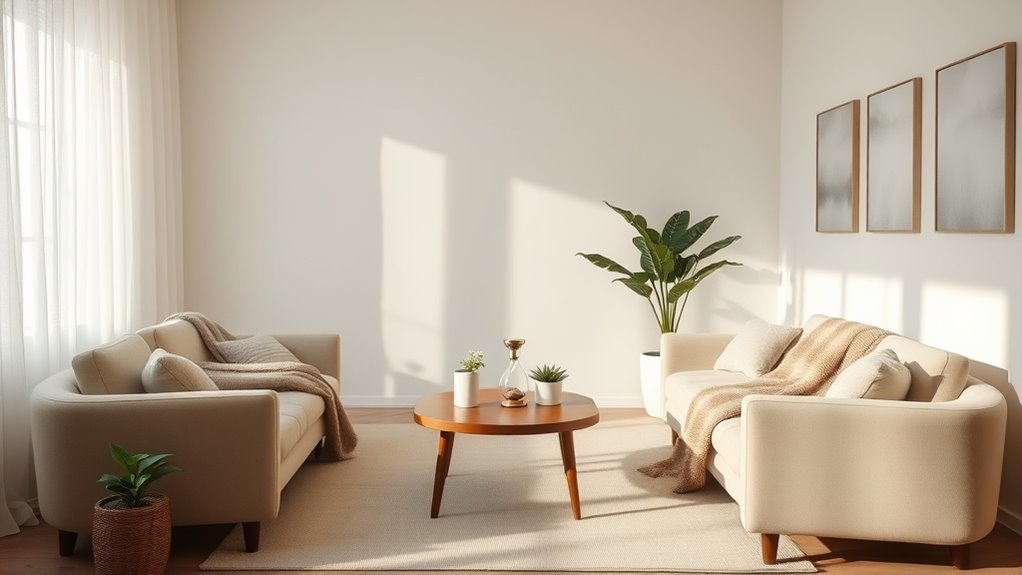To create an effective quiet room for overstimulated guests, choose a calm, secluded spot away from noise and distractions. Use soothing colors, soft lighting, and minimal decor to promote relaxation. Add comfortable, adjustable seating and sensory tools like noise-canceling headphones or textured toys. Keep the space clean, organized, and clearly marked for easy access. Implement rules for respectful use and gather feedback to keep the environment supportive—learn more about optimizing this space below.
Key Takeaways
- Choose a quiet, minimally noisy space with consistent temperature and soft, neutral decor to promote relaxation.
- Equip the room with sensory-friendly items like fidget tools, noise-canceling headphones, and calming aromas.
- Use soft lighting, soundproofing, and minimal decor to create a soothing, clutter-free environment.
- Establish clear rules for noise levels, privacy, and time limits to maintain a peaceful atmosphere.
- Regularly gather guest feedback to adjust the environment and ensure it effectively supports overstimulated visitors.
Selecting a Calm and Comfortable Location
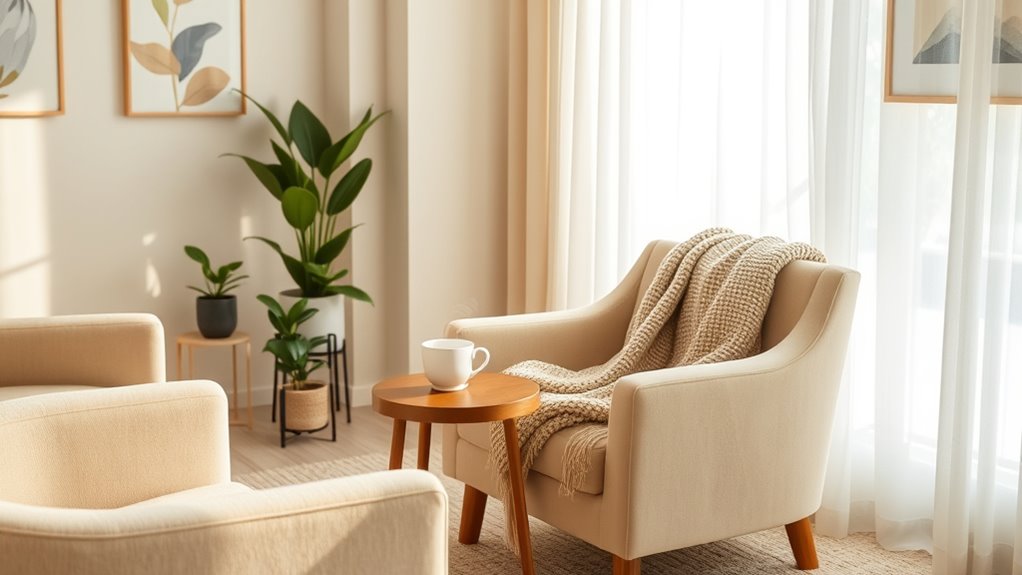
Choosing the right location is essential for creating a peaceful room setup. You want a spot that minimizes background noise, so your space remains calm and undisturbed. Look for an area away from busy hallways, loud appliances, or street sounds. Temperature control is equally important—you need a room that stays comfortably cool or warm without constant adjustments. Avoid places near windows that let in drafts or areas with uneven heating. Ideally, select a quiet corner of your home or office that naturally muffles external sounds and maintains a consistent temperature. This soundproofing helps to further create a soothing environment, ensuring overstimulated guests feel more relaxed and at ease. A well-chosen location ensures your quiet room remains truly peaceful.
Choosing Soothing Colors and Decor
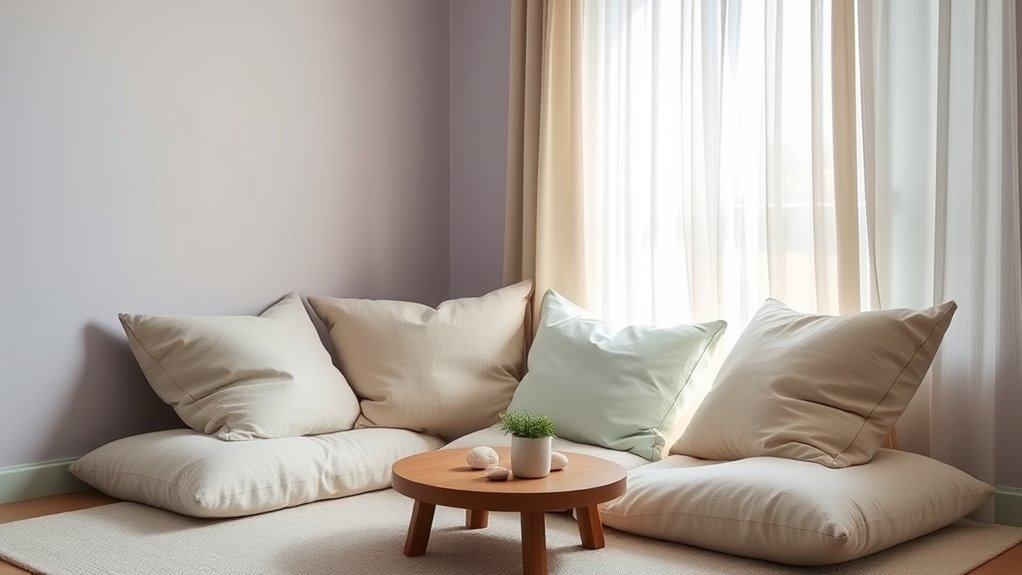
Selecting calming colors and decor can transform your quiet room into a truly soothing space. Soft, neutral tones like pastels, beige, or gentle blues create a peaceful environment. Incorporate elements that promote relaxation, such as natural textures or simple artwork. To enhance the calming atmosphere, consider these tips:
- Use background music with gentle melodies to reduce overstimulation
- Choose scent selection options like lavender or chamomile for calming aromas
- Keep decor minimal to avoid visual clutter
- Opt for soft lighting that complements the color scheme
- Remember that a focused environment enhances attention, which in turn boosts the overall calming effect.
Incorporating Comfortable Seating Options
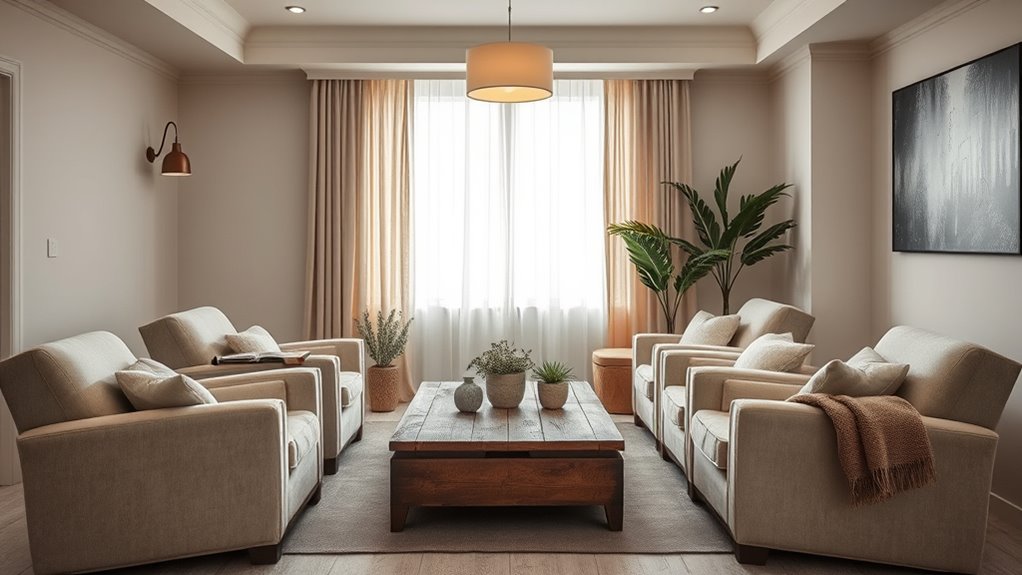
To create a truly relaxing space, incorporating comfortable seating options is essential. Start with adjustable chairs that allow guests to customize their position for maximum comfort. Look for chairs with ergonomic cushions to provide proper support, reducing tension and promoting relaxation. These cushions help distribute weight evenly and prevent discomfort during longer breaks. Consider adding a variety of seating styles, such as lounge chairs or cushioned stools, to accommodate different preferences. Guarantee the seating setup encourages guests to unwind and feel at ease, avoiding cramped or hard surfaces. By prioritizing adjustable chairs and ergonomic cushions, you create a welcoming environment that supports overstimulated guests in finding comfort and tranquility quickly. Additionally, selecting ergonomic design furniture ensures long-term comfort and health benefits. This thoughtful approach helps foster a calming atmosphere essential for effective breaks.
Adding Soft Lighting and Soundproofing Measures
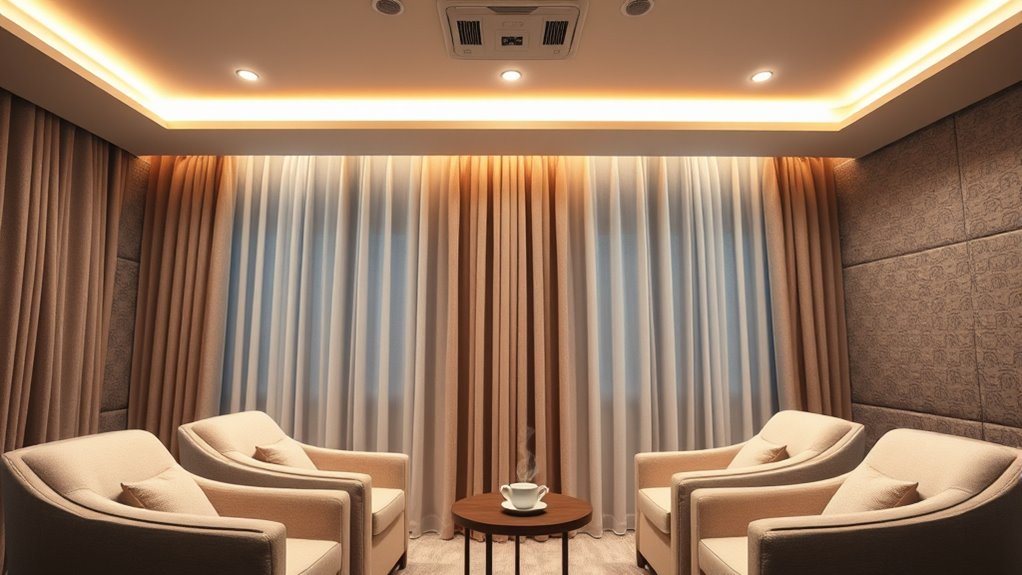
Creating a calming atmosphere in your quiet room begins with soft lighting and effective soundproofing. Gentle, warm lights reduce overstimulation and promote relaxation. Consider using dimmable lamps or fairy lights for a soothing glow. Soundproofing helps block outside noise and minimizes distractions. You can add silent art, like textured panels or calming visuals, that don’t produce sound but create visual serenity. Incorporate aromatherapy options, such as essential oil diffusers, to add calming scents that support relaxation. To enhance the quiet space, focus on these key points:
- Use blackout curtains or soundproof window inserts
- Incorporate silent art for visual calm
- Choose low-wattage, warm-colored lighting
- Add aromatherapy options for sensory soothing
- Implement soundproofing techniques to further reduce external noise
These measures create an environment that’s both peaceful and conducive to recovery from overstimulation.
Providing Sensory-Friendly Items and Tools

Building on the calming environment established through soft lighting and soundproofing, adding sensory-friendly items and tools can further tailor the space to individual needs. Fidget tools, such as stress balls or textured toys, help guests manage anxiety and stay grounded. Noise canceling headphones are essential for reducing overwhelming sounds, allowing overstimulated guests to regain calmness quickly. Keep these items easily accessible and clean, so guests can use them as needed. Incorporate a variety of textures and types to suit different preferences. By providing these tools, you create a supportive environment that encourages relaxation and self-regulation. Remember, the goal is to make the quiet room a flexible, responsive space where guests feel empowered to soothe themselves comfortably. Regularly cleaning and inspecting essential oils and sensory tools ensures safety and maintains their effectiveness.
Ensuring Easy Access and Clear Signage
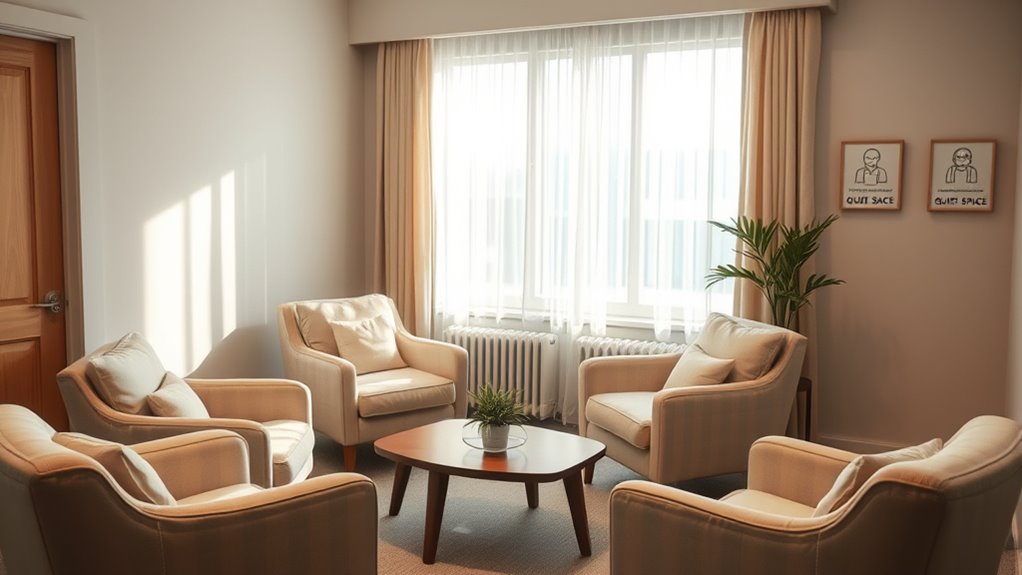
How can you make sure guests easily find and access the quiet room? Start by placing clear, visible signage at key points, like entrances and main hallways. Signage placement should be intuitive, guiding guests directly to the room without confusion. Incorporate accessibility features—such as ramps, wide doorways, and braille signs—to guarantee everyone can access it comfortably. Use high-contrast colors and large fonts for readability. Keep signs simple, with straightforward wording like “Quiet Room” or “Sensory Break Area.” Regularly check that signs are unobstructed and well-lit. Consistent signage placement and visual cues help overstimulated guests find refuge quickly, reducing stress and making your quiet room truly welcoming.
Maintaining Cleanliness and Organization
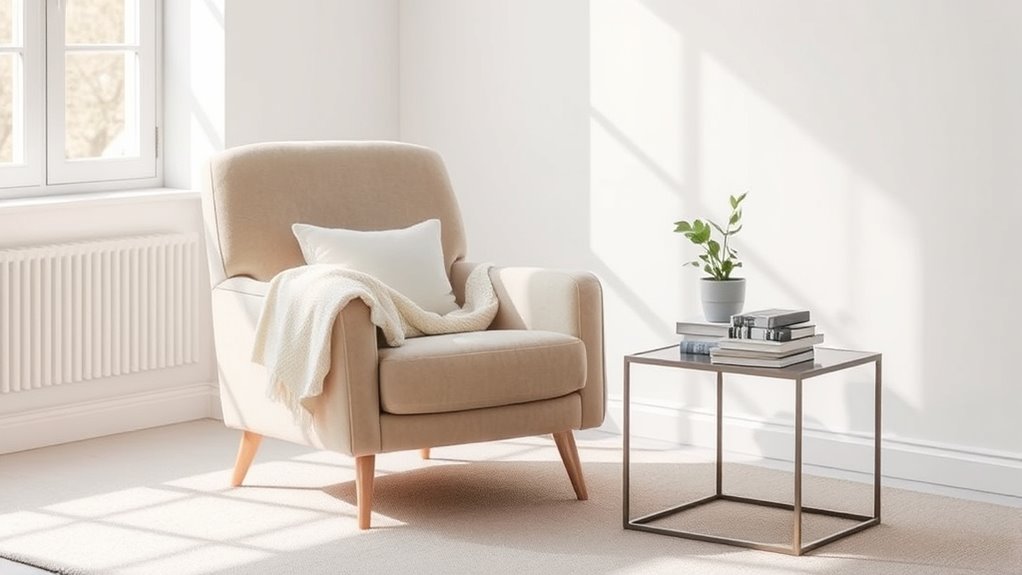
Keeping your quiet room clean and organized is essential for providing a calming environment. A clutter-free space helps reduce unnecessary noise levels, making it easier for guests to relax without distractions. Regularly tidy up and designate specific areas for personal belongings to maintain order. This not only promotes a sense of calm but also respects your guests’ privacy, as they feel confident their items are secure and undisturbed. Verify that surfaces are clean and free of dust or debris, which can contribute to discomfort or overstimulation. Incorporating organized storage solutions can streamline organization and help guests find what they need quickly. Overall, maintaining cleanliness and orderliness supports a peaceful atmosphere and demonstrates your thoughtfulness in creating a safe, private space for every guest.
Encouraging Respectful Use and Guest Feedback
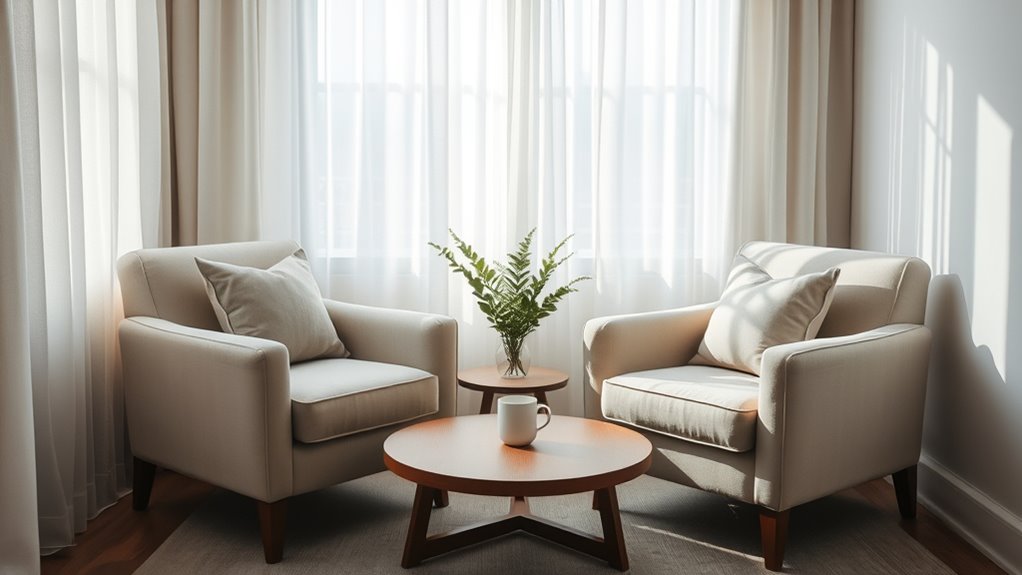
Setting clear room guidelines helps guests understand how to use the space respectfully. You should also encourage visitors to share their feedback, so you can make improvements. Listening to guest perspectives guarantees the quiet room remains welcoming for everyone. Additionally, practicing mindful decluttering techniques can create a more peaceful environment that benefits all users.
Clear Room Guidelines
To guarantee everyone has a positive experience in the quiet room, it’s important to establish clear guidelines for respectful use. Setting expectations helps maintain noise reduction and privacy safeguards, ensuring comfort for all guests. Be sure to communicate that conversations should be kept low, and devices on silent to prevent disturbances. Respect others’ privacy by avoiding unnecessary interruptions or intrusions. Encourage guests to provide feedback on their experience to improve the space continually. Clear guidelines foster a calm environment and promote mutual respect. Consider posting simple rules visibly at the entrance, such as:
- Keep noise levels low
- Respect others’ privacy
- Limit use time if needed
- Share feedback honestly
Implementing these rules helps create a safe, peaceful space for overstimulated visitors. Additionally, reminding guests to use waterproofing spray on any fabric or canvas surfaces can help maintain a clean and comfortable environment.
Gather Visitor Perspectives
How can you guarantee that the quiet room continues to meet guests’ needs? The key is actively gathering visitor perspectives through feedback collection. Encourage guests to share their experiences honestly, whether through comment cards, digital surveys, or casual conversations. Listening to visitor experiences helps you identify what’s working and what needs adjustment. Respectful use is reinforced when guests see their input valued and acted upon. Regularly reviewing feedback allows you to refine the quiet room setup, ensuring it remains a calming refuge for overstimulated guests. By fostering open communication, you create an environment where visitors feel heard and respected. This ongoing dialogue helps maintain a space that truly supports their needs and enhances their overall experience. Incorporating guest feedback into your management strategies further ensures the space adapts effectively to diverse preferences and sensitivities.
Frequently Asked Questions
How Do I Determine the Ideal Size for a Quiet Room?
You determine the ideal size for a quiet room by prioritizing guest comfort and noise levels. Opt for a space large enough to prevent noise from spilling in or out, allowing guests to relax without feeling cramped. Consider the number of guests who might use the room simultaneously and include comfortable seating and calming decor. A well-sized quiet room enhances relaxation, minimizes overstimulation, and guarantees a peaceful experience for all guests.
What Safety Measures Should Be Implemented in the Quiet Room?
Like a well-oiled steampunk mechanism, you should implement safety measures in the quiet room by ensuring clear emergency exits are unobstructed and prominently marked. Install smoke detectors and fire extinguishers to uphold fire safety standards. Regularly check that all safety equipment functions properly. Train staff on emergency procedures, so they can assist guests swiftly. These measures help protect overstimulated guests and maintain a secure, calming environment.
How Often Should the Quiet Room Be Cleaned and Maintained?
You should clean and maintain the quiet room at least once daily to guarantee guest comfort and uphold a high cleanliness schedule. Regular cleaning prevents dust and allergens from accumulating, creating a safe, calming environment. Additionally, check for any damages or needed repairs during each cleaning. By maintaining a consistent schedule, you help guests feel relaxed and cared for, reducing overstimulation and promoting a positive experience.
Are There Specific Materials Recommended for Soundproofing?
You wonder how to block out the chaos. Use acoustic panels strategically placed on walls to absorb sound, creating calm. For extra isolation, hang soundproof curtains over windows and doorways—these act as barriers, muffling noise. Combine both for maximum effect, transforming the space into a sanctuary. The right materials make all the difference, ensuring your quiet room truly offers a peaceful refuge for overstimulated guests.
How Can I Encourage Guests to Use the Quiet Room Appropriately?
You can encourage guests to use the quiet room appropriately by providing clear guest education, explaining its purpose and benefits. Place effective signage near entrances and common areas, emphasizing respectful use and quiet behavior. Additionally, consider friendly reminders from staff, guiding overstimulated guests to the room when needed. This proactive approach helps normalize usage and ensures guests understand the importance of maintaining a calm environment for everyone.
Conclusion
Creating a quiet room offers a gentle sanctuary where overstimulated guests can find peace. Picture soft lighting casting a calming glow, plush seating inviting relaxation, and soothing colors wrapping them in comfort. When you design this space thoughtfully, you give others a safe harbor amid chaos, a place to breathe and reset. Your effort transforms a simple room into a heartfelt refuge, where tranquility and understanding bloom, making everyone feel truly cared for.
